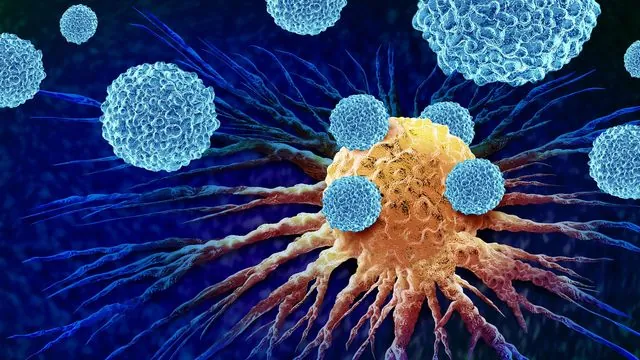
Breakthrough in Cancer Treatment: Virtual Screening Speeds Up Immunotherapy Drug Discovery!
2024-11-11
Author: Mei
Introduction
Researchers at Weill Cornell Medicine have made an exciting leap in the quest for more efficient cancer immunotherapy by harnessing the power of virtual drug screening. This innovative approach promises not only to expedite the identification of small molecule drug candidates but also to provide smarter options in the fight against cancer.
Traditional Cancer Immunotherapy vs. New Findings
Traditionally, cancer immunotherapies, known as checkpoint inhibitors, have relied on large lab-produced proteins called monoclonal antibodies. These heavyweights must be infused into the bloodstream and work by blocking checkpoint proteins that deliver 'off' signals, thereby unleashing T cells to combat cancer. However, the latest findings indicate a potential pivot to smaller, more versatile molecules that can enhance treatment accessibility and efficacy.
Significance of the Research
Dr. Moustafa Gabr, assistant professor of chemistry in radiology and senior author of the study, emphasizes the significance of this research. 'Our advancements could represent a promising alternative to monoclonal antibody treatments,' he stated, spotlighting the potential benefits of small molecules for patients.
Publication Details
Published on October 16 in the prestigious journal Science Advances, this groundbreaking study explores a method to virtually screen millions of chemical compounds. The goal is to identify small molecules capable of binding to immunological checkpoints, amplifying the body's natural defenses against cancerous cells. One of the major advantages of these small molecules is their oral bioavailability, allowing for easier administration, customizable dosing, and better patient adherence to treatment regimens.
Challenges Overcome
Targeting immune checkpoint proteins has long been tricky due to their flat and dynamic surfaces that resist binding with small molecules. To tackle this challenge, Dr. Gabr and lead author Dr. Somaya Abdel-Rahman—assistant professor of pharmacy at Mansoura University in Egypt—analyzed co-crystal structures of immune checkpoints in complex with monoclonal antibodies. This analysis facilitated the creation of 'pharmacophore' maps, three-dimensional representations that highlight crucial binding interactions.
Through advanced computational tools, they identified important molecular interaction sites and carried out a virtual screening of a vast database of commercially available small molecules. The promising candidates demonstrated binding characteristics akin to those of existing monoclonal antibodies, hinting at their potential efficacy.
Validating Breakthrough Compounds
The next step was to validate these compounds, focusing on their binding affinity and specificity, crucial metrics that reveal how effectively a drug can interact with its target. The research team conducted cellular tests to evaluate the functional impacts of these small molecules on immune checkpoint activity.
One standout contender was MG-T-19, which effectively inhibited the TIM-3 checkpoint receptor associated with numerous immune cells. Blocking TIM-3 can invigorate T cell responses against tumors. Another promising molecule, MG-V-53, was recognized for its ability to inhibit VISTA, another checkpoint implicated in aiding tumor immune evasion.
'The small molecules identified not only show robust binding affinities but also exhibit anti-tumor activity in mouse models,' remarked Dr. Gabr. This finding could pave the way for the clinical development of these potential therapies, an exciting prospect for cancer treatment.
Future Directions
Moving forward, the research team aims to optimize these top compounds for clinical use and investigate their combined effects in multi-drug therapies. They plan to broaden this innovative screening technique to target additional immune checkpoint proteins, signaling a new era of cancer therapies. 'We believe this study has the potential to broaden the landscape of cancer treatments, ultimately improving patient outcomes and igniting fresh avenues for research,' Dr. Gabr concluded.
Conclusion
This breakthrough represents not just scientific progress, but a hopeful stride toward revolutionizing cancer therapy and providing new hope to patients worldwide. Stay tuned as we follow this developing story!




 Brasil (PT)
Brasil (PT)
 Canada (EN)
Canada (EN)
 Chile (ES)
Chile (ES)
 España (ES)
España (ES)
 France (FR)
France (FR)
 Hong Kong (EN)
Hong Kong (EN)
 Italia (IT)
Italia (IT)
 日本 (JA)
日本 (JA)
 Magyarország (HU)
Magyarország (HU)
 Norge (NO)
Norge (NO)
 Polska (PL)
Polska (PL)
 Schweiz (DE)
Schweiz (DE)
 Singapore (EN)
Singapore (EN)
 Sverige (SV)
Sverige (SV)
 Suomi (FI)
Suomi (FI)
 Türkiye (TR)
Türkiye (TR)